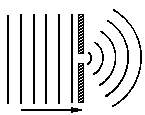Diffraction
Diffraction is the bending of waves around obstacles, or the spreading of waves as they pass through an opening, most apparent when looking at obstacles or wavelengths having a size of the same order of magnitude as the wavelength. Typically, the smaller the obstacle and wavelength, the greater the diffraction. Taken to the extreme, when a wave is blocked by a small enough opening, the wave passing through the opening actually behaves like a point source for a new wave.
You can observe diffraction quite easily... I'm sure you've heard a noise from a room with an open door even when your ears aren't in a direct line from the sound source... this is a result of diffraction of the sound waves around the door opening (along with some reflection of sound as well).
Thomas Young's Double-Slit Experiment is a famous experiment which utilized diffraction to prove light has properties of waves. Young placed a single-wavelength light source behind a barrier with two narrow slits, allowing only a small portion of the light to pass through each slit. Because the two light waves travel different distances to the screen on which they are projected, you can see effects of both constructive and destructive interference, phenomena that occur only for waves!
Question: The spreading of waves into the region behind an obstacle is known as _______.
Answer: diffraction
Question: Which wave phenomenon is represented in the diagram?
Answer: diffraction


